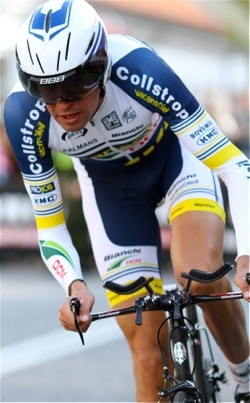Gonzalo is one of the more experienced riders into power meter training as he has been training with power for the last three years (SRM, Ergomo and now PowerTap SL). What he was looking for was a training program that could motivate him for training to cycling races of 80-90km. Motivation is the cornerstone in many riders training program, because even the best program will end up as a failure if the rider is not motivated. I guess a part of the predicted progress can be explained by motivation. A motivated rider trains harder and obtains better results than a non-motivated rider. Thus, my challenge was to motivate Gonzalo and keep track of his performance during the 12 weeks.
Focus on Aerobic Power
I decided to focus on 5 and 20min maximum power in the first 6 weeks and then work harder with anaerobic power in the last 6 weeks. I prefer to build a great aerobic base instead of just working on the anaerobic stuff from the very beginning. The reason for this is that it takes longer to build an optimal aerobic engine than anaerobic endurance. It is quite fast to train anaerobic endurance to a relative high level compared to the time it takes to optimize maximum oxygen consumption. Well, but he asked for more anaerobic endurance and sprinting power? Yes, but in cycling races of 2 hours it is essential to have a high VO2 max and endurance. If he got that, he has a chance to get home with the peloton or even make a breakaway. But if he is limited in these two factors, VO2 max and endurance, he will be dropped before they get to the final sprint. Thus, the primary goals for the first period were improvements in 5 and 20min maximum power.
Intervals
Like all the other riders in this project Gonzalo had to struggle with intervals three times a week. In the first couple of week it was two days with intervals and on Sundays he participated in some duathlon events of 2hrs duration. The following weeks were with intervals on Tuesdays, Thursdays and Saturdays.
Gonzalo performed several intervals of 6min work / 4min active recovery with a workload around his 20min maximum power (Normally done three times on each interval day). There were also a couple of days 3x(3+3)min and 40/20sec intervals to maximize his VO2 max and add some fuel to his anaerobic enzymes.
Results
1min power increased dramatically making him a much stronger rider with more punch in his attacks. Combined with significant improvements in 5 and 20min maximum power, Gonzalo is now a lot more competitive in flat cycling races. I could wish that he was stronger in sprints, but the 1, 5 and 20min maximum power will result in more success for him in the races after all.
| Maximum Power Tests |
5sec |
1min |
5min |
20min |
Body Weight |
| Week 1 (Watt) |
1105W |
557W |
357W |
321W |
73kg/160.9lbs |
| Week 1 (Watt/kg) |
15.1W/kg |
7.6W/kg |
4.9W/kg |
4.4W/kg |
|
| Week 6 (Watt) |
1148W |
604W |
389W |
335W |
72.5kg |
| Week 6 (Watt/kg) |
15.8W/kg |
8.3W/kg |
5.4W/kg |
4.6W/kg |
|
| Week 12 (Watt) |
1113W |
674W |
416W |
342W |
73kg |
| Week 12 (Watt/kg) |
15.2W/kg |
9.2W/kg |
5.7W/kg |
4.7W/kg |
|

